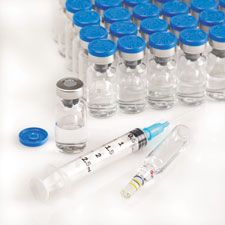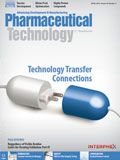Container Selection for Biologic Formulations
Choosing the right container and container closure system is crucial for ensuring product quality, safety, and efficacy of a biologic formulation.
MARIA TOUTOUDAKI/GETTY IMAGES

The compatibility of a biologic formulation with its primary packaging and container closure system is key to maintaining the stability of drug product and preserving its safety and efficacy.
Pharmaceutical Technology spoke to subject matter experts from Pfizer CentreOne about the importance of choosing the right container and container closure system for biologics formulations and understanding the impact of primary packaging materials on the drug product. Pfizer CentreOne, a global contract manufacturing organization, was formed by the union of CMOs Pfizer CentreSource and Hospira One 2 One.
Experts include Lisa Cherry, R&D manager; Martin Gonzalez, PhD, senior group leader, R&D; and Shen Chen, PhD, director, Pharmaceutical R&D, all three from Pfizer CentreOne; and Kerry Mulvaney, senior scientist, MS&T, Global Technology Services, Pfizer Inc.
Selecting the right containerPharmTech: Why is it important to select the right container and container closure system for biologic formulations?
Pfizer CentreOne: Maintaining stability of a large molecule is of utmost importance and has to be considered at every step of the manufacturing and packaging process. Metal ions, pH, salts, silicone, gases, and leachables can all affect the stability in a container closure system. If a biomolecule becomes unstable, resulting in structural damage of the protein, it will lead to a propensity for aggregation of the drug product. Aggregation is a safety and efficacy issue that can lead to an immunogenic response within a patient. This means that the patient’s immune system could generate antibodies to attack the drug product, which can lead to drug clearance or neutralization. The bottom line is that choosing the wrong container and container closure system may put patients in jeopardy, especially if they are taking medication for a serious condition.
PharmTech: What are the causes of incompatibility between a biologic formulation and its container?
Pfizer CentreOne: Incompatibility can occur by not fully understanding the material surface properties of the container. Some characteristics to consider include the container surface chemistry, surface wettability, dimensional consistency, and surface roughness. Protein may also adsorb to silicone oil, which is often used in prefilled syringe and cartridge systems. In other words, we need to consider any material characteristics that may lead to protein adsorption because adsorption can lead to protein aggregation.
Another source for incompatibility would be with the rubber formulation for the stopper, plunger, or seal. Rubber components often contain additives and fillers to help strengthen the components. These additives and fillers, however, may contain trace metals that could leach into the drug product over time. This type of contamination may lead to protein damage.
PharmTech: Can you talk about the components of the primary packaging materials and their impact on a biologic formulation?
Pfizer CentreOne: Typical containers for drug product biologics are made of glass or plastic and include vials, prefilled syringes, and cartridges. Each has a different set of closures: rubber stoppers for vials; plunger, needle, and needle shield (or luer tip and cap) for prefilled syringes; and plunger and seal for cartridges.
All three container systems carry risk of interactions. We need to consider potential rubber-component leachables, as well as protein-silicone interactions. In particular, non-uniform silicone coating of containers is a real concern for protein stability over time. Tungsten may also be a problem. Prefilled syringes may be manufactured using a tungsten pin to shape the syringe tip. Residual tungsten in the syringe is a concern for biologics; it may become oxidized, cause a pH shift in the drug product solution, and lead to induction of protein aggregation. Prefilled syringe manufacturers are aware of this concern and are now marketing low-tungsten-containing syringes.
PharmTech: So what are the key considerations when selecting a container and container closure system for a biologic drug product?
Pfizer CentreOne: The key consideration for initial container selection should be to choose components that maintain product stability by minimizing protein adsorption, extractables/leachables, oxidation, and pH changes. Another is the intended route of administration. Container selection for a liquid medicine, for example, requires different considerations than a lyophilized one. For instance, evaluating protein interaction with silicone in a prefilled syringe or cartridge system is more important for a liquid than a lyophilized medicine. Components must also meet functional requirements to ensure safety at the point of administration and to protect the purity of the drug product throughout its shelf life. Finally, to expedite medications that meet unmet medical needs so that patients get them more quickly, choosing a reliable, tried-and-true container closure system such as a vial may facilitate market approval. More novel container closure systems could follow according to lifecycle management strategy.
PharmTech: Which is better for biologics, glass or plastic? How do you decide which to use?
Pfizer CentreOne: This is really molecule- and formulation-dependent. Knowing the molecule’s sensitivities is imperative. For example, if a biomolecule is sensitive to oxygen, a semi-permeable plastic container may not be optimal. However, if a biomolecule formulation leads to delamination in glass and does not exhibit oxygen sensitivity, a plastic container may be ideal. Certain types of glass and plastics can also cause wider variations in the drug product solution’s pH; again, pH changes can affect product stability, leading to potential protein aggregation.
In addition, we need to evaluate end-user requirements. A medication in one container closure system may be better suited for an emergency-care setting rather than for self-administration. Human-factor studies provide valuable information for assessing an appropriate container closure system from a patient usability perspective.
PharmTech: What testing or characterization studies do you have to carry out to determine compatibility of the biologic formulation with the container and container closure system?
Pfizer CentreOne: The main objective for determining compatibility would be to ensure that the biomolecule is stable in its container closure system. A typically ‘happy’ protein will exhibit maximum biological potency and minimal aggregation, denaturation, and/or damage. Initially, we can perform material contact studies to examine adsorption of the molecule to relevant container closure materials as well as contact effects on the potency and other critical quality attributes of the drug product. This type of study could be used for screening materials (for example, glass with different coatings) as well.
Once we choose a container closure system, filled drug product units should be tested under stress (temperature, humidity, light, and agitation) and normal storage conditions. For certain types of containers, functionality testing is extremely important. Prefilled syringe and cartridge systems require proper functionality to deliver the intended dose. Glide force and break-loose force are common tests to ensure the liquid drug product is delivered smoothly and accurately. These types of mechanical tests should be included with stability studies.
PharmTech: What about the issue of extractables and leachables?
Pfizer CentreOne: Rubber components are a significant contributor to leachables because they contain additives and fillers including transition metals, which could leach into the drug product over time. This type of contamination may lead to protein damage, especially when the product is exposed to agitation (air-liquid interface exposure). Another source of recent concern would be leachables from the adhesive used to attach the needle to a prefilled syringe system.
Stability testing of the drug product should monitor protein stability; changes in protein aggregation, oxidation, degradation, pH changes, and particulate matter can be indicators of compatibility. Stress studies, including agitation, can also provide key insights to compatibility.
Packaging trendsPharmTech: What recent trends do you see in primary packaging of biologic drugs?
Pfizer CentreOne: As patients are taking a more active role in their healthcare, we are seeing more and more packaging systems that provide greater ease of use. Glass vial presentations have been moving towards prefilled syringe systems, especially as part of a lifecycle management approach. Dual-chamber prefilled syringes, allowing for mixing of a drug product immediately prior to application, have developed interesting applications in the biopharmaceutical market. There is some movement towards the use of layered plastic containers, such as cyclic olefin copolymer and cyclic olefin polymer, which prevent gas transmission into the drug product. Specialty pens, patches, and containers for self-infusion pump devices are also popular.
Article Details
Pharmaceutical Technology
Vol. 40, No.4
Page: 24-26
Citation:
When referring to this article, please cite it as A. Siew, “Container Selection for Biologic Formulations," Pharmaceutical Technology 40 (4) 2016.
Editor's Note: The article was updated from its original version to reflect changes in the company's name.

Pharmaceutical Tariffs Are Imminent: How Industry is Bracing for Impact
April 16th 2025On April 14, 2025, the Trump Administration launched a national security-driven investigation into pharmaceuticals, a move that will likely result in tariffs being placed on pharmaceutical drugs, ingredients, and other components that are imported from outside of the United States.
Drug Solutions Podcast: A Closer Look at mRNA in Oncology and Vaccines
April 30th 2024In this episode fo the Drug Solutions Podcast, etherna’s vice-president of Technology and Innovation, Stefaan De Koker, discusses the merits and challenges of using mRNA as the foundation for therapeutics in oncology as well as for vaccines.